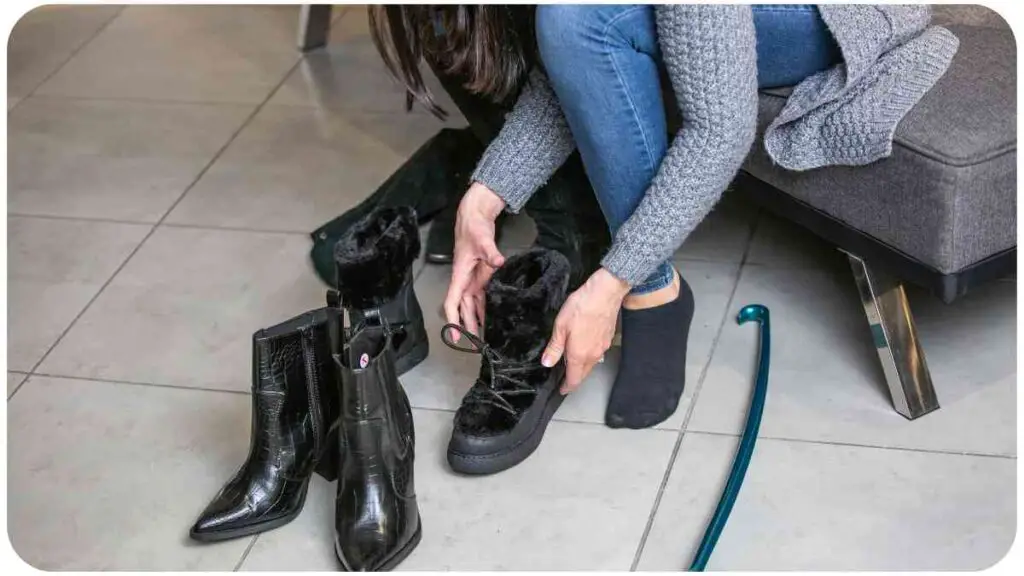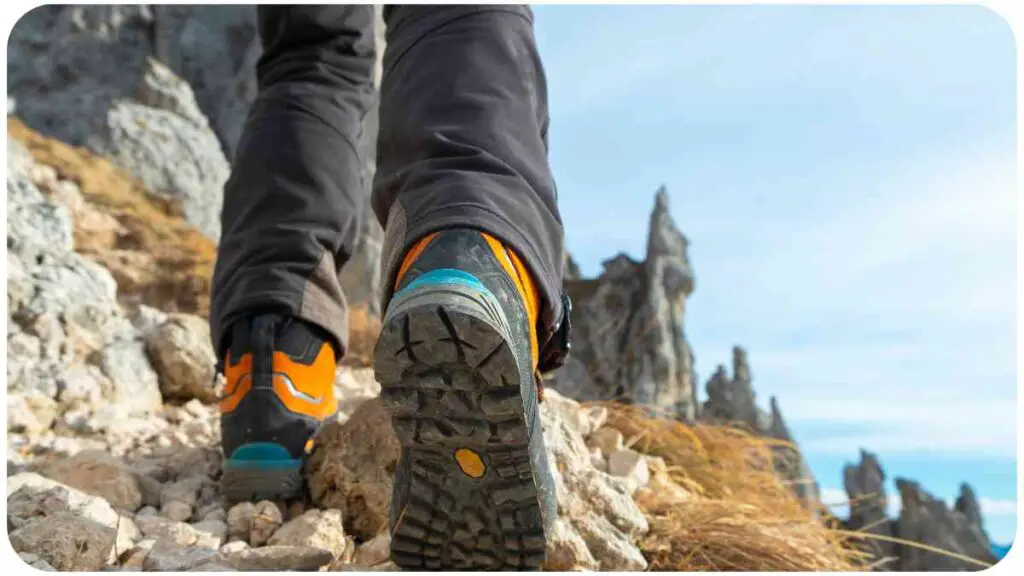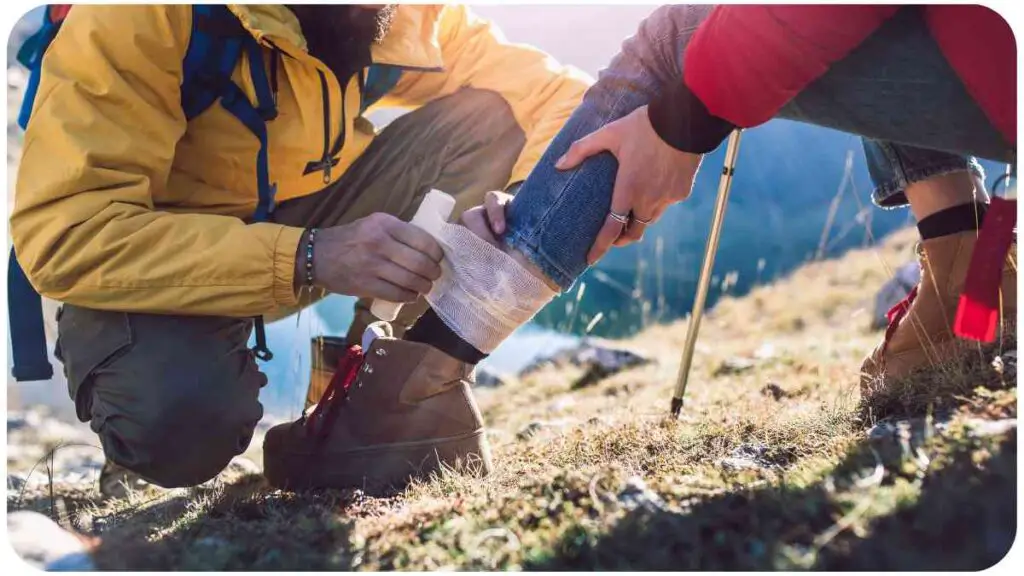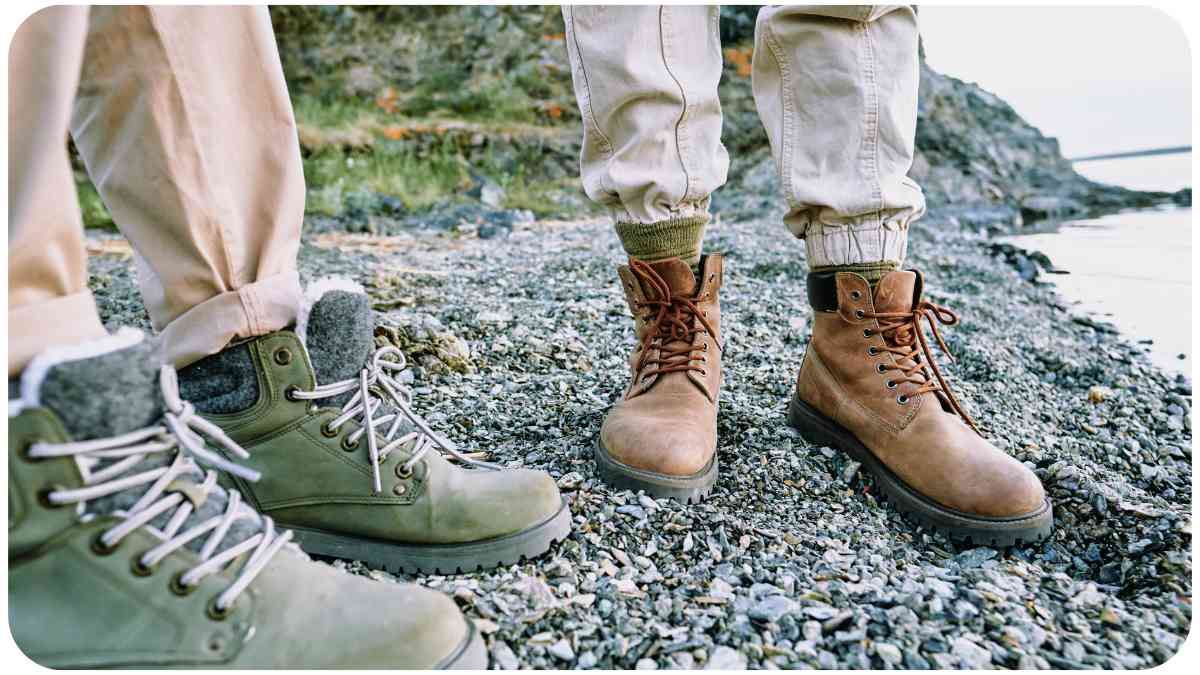Hiking is a delightful adventure, but what happens when your trusted Salomon hiking boots start causing discomfort? In this comprehensive guide, we’ll delve into understanding and overcoming Salomon hiking boot discomfort.
Whether you’re a seasoned hiker or just starting, ensuring your boots fit perfectly is essential for an enjoyable trek. Let’s embark on this journey to happy trails with your Salomon boots.
Hiking boot discomfort can stem from various factors, including improper fit, inadequate support, or wear and tear. Identifying the root cause is crucial for effective solutions.
The right fit is not just about comfort; it’s about preventing injuries and ensuring your boots can withstand the challenges of the trail. Let’s explore how you can choose the perfect Salomon hiking boot for your feet.
| Takeaway |
|---|
| 1. Choose the right Salomon model based on your foot type and size for a perfect fit. |
| 2. Gradually break in your boots, using stretching techniques if needed. |
| 3. Address common discomfort with suitable insoles and arch support options. |
| 4. Maintain your boots with proper cleaning, waterproofing, and storage. |
| 5. Upgrade insoles for prolonged comfort, and personalize lacing techniques. |
| 6. Consider temperature extremes with insulated models for cold weather and breathable options for warmth. |
| 7. Prioritize safety on the trail and be prepared with a first aid kit for unexpected discomfort. |
| 8. Learn from real-life experiences and community recommendations for informed decisions. |
| 9. Pay attention to sock choice and listen to your feet for a personalized and enjoyable hiking experience. |
| 10. Explore further reading for in-depth advice on breaking in your hiking shoes. |
2. Choosing the Right Salomon Hiking Boot

2.1 Identifying Your Foot Type
Before diving into Salomon’s vast range, understand your foot type. Are you flat-footed, have a neutral arch, or high arches? Different Salomon models cater to varying foot types, ensuring optimal support and comfort.
Discover the essentials for a 7-mile hike. From proper gear to snacks, ensure your hiking experience is comfortable and enjoyable with these must-have items.
Table: Foot Types and Suitable Salomon Models
| Foot Type | Recommended Salomon Models |
| Flat-footed | X Ultra 3, X Ultra 4 |
| Neutral Arch | Quest 4D, OUTline GTX |
| High Arches | X Raise, XA Pro 3D V8 |
2.2 Size Matters: Ensuring the Perfect Fit
No matter how advanced the features, the wrong size can lead to discomfort. Consult the Salomon size chart for your chosen model, considering both length and width for a snug fit.
Table: Salomon Size Chart for Different Models
| Salomon Model | Size Range (US Men’s) | Size Range (US Women’s) |
| X Ultra 3 | 7-15 | 5-12 |
| Quest 4D | 8-14 | 6-11 |
| X Raise | 6-13 | 5-11 |
3. Breaking In Your Salomon Hiking Boots
3.1 Gradual Wear Approach
New boots often require a breaking-in period. Don’t rush it! Gradually increase wear time to allow the materials to adapt to your foot shape. This helps prevent discomfort and blisters.
Curious about hiking Besseggen’s duration? Explore the time it takes to complete this scenic hike, providing insights for planning your next outdoor adventure.
3.2 Utilizing Boot Stretching Techniques

If specific areas of your Salomon boots feel too tight, consider stretching techniques. Refer to the table below for effective ways to expand your boots where needed.
Table: Techniques for Stretching Salomon Hiking Boots
| Boot Area | Stretching Technique |
| Toe Box | Use a Boot Stretcher |
| Heel Counter | Warm with a Hairdryer, Wear Thick Socks |
| Width Adjustment | Insert Boot Stretching Spray |
4. Addressing Common Discomfort Issues
4.1 Heel Pain and Blisters
Heel pain and blisters are common discomfort issues. Choosing the right insole can make a significant difference. Let’s explore various insole options compatible with Salomon boots.
Uncover the truth about waterproof hiking boots. Our expert recommendations guide you in selecting the right boots to keep your feet dry and comfortable on the trail.
Table: Recommended Salomon Insole Options
| Insole Type | Features |
| Ortholite Insoles | Provides cushioning and breathability |
| Salomon Orthopedic Insoles | Designed for enhanced arch support and comfort |
| Gel Insoles | Offers additional shock absorption |
Investing in the right insole can alleviate heel pain and reduce the likelihood of blisters during your hikes.
4.2 Arch Discomfort
Arch discomfort can be a result of inadequate arch support. Salomon offers specific solutions to address this issue. Let’s explore the available options.
Table: Salomon Arch Support Options
| Arch Type | Recommended Salomon Products |
| Low Arch | X Ultra 4 with Ortholite insoles |
| Medium Arch | OUTline GTX with customized insoles |
| High Arch | XA Pro 3D V8 with built-in arch support |
5. Maintaining Your Salomon Hiking Boots
5.1 Cleaning and Waterproofing
Regular maintenance is crucial for the longevity of your Salomon boots. Clean them after each hike and apply waterproofing treatments. Here are some recommended products to keep your boots in top shape.
Enhance your hiking experience with insights into lacing techniques for trail runners. Discover optimal lacing methods that ensure a secure fit, reducing discomfort during your trail adventures.
Table: Recommended Cleaning and Waterproofing Products
| Product | Purpose |
| Nikwax Footwear Cleaning Gel | Cleans without damaging materials |
| Grangers Footwear Repel | Provides water repellency |
| Salomon Boot Bag | Convenient for storage and transport |
5.2 Storage Tips for Longevity
Proper storage is key to preserving your boots. Avoid leaving them in direct sunlight or damp conditions. Use a boot bag for protection and ensure they are clean and dry before storing.
Maintaining your Salomon boots enhances their durability, ensuring they remain a reliable companion on your hiking adventures.
6. Upgrading Insoles and Inserts
6.1 Assessing the Need for Replacement
As your Salomon hiking boots age, the insoles may lose their original support. Regularly assess the condition of your insoles, and if needed, consider replacements to maintain optimal comfort.
6.2 Top Salomon-Compatible Insoles
Choosing the right replacement insoles is crucial for continued comfort. Let’s compare some popular Salomon-compatible insoles.
Are you considering using hiking boots for work? Explore the versatility of hiking boots beyond the trail, providing comfort and support for your feet throughout your workday.
Table: Comparison of Salomon-Compatible Insoles
| Insole Brand | Features |
| Superfeet GREEN | High arch support, durable construction |
| Sole Active Medium | Moldable support, moisture-wicking |
| Salomon Ortholite | Designed specifically for Salomon boots |
Upgrading your insoles can breathe new life into your boots, providing the support needed for those challenging trails.
7. Dealing with Temperature Extremes
7.1 Cold Weather Considerations
Extreme temperatures can impact your hiking experience. If you’re venturing into cold climates, having insulated Salomon boots is crucial. Let’s explore some insulated Salomon models.
Table: Insulated Salomon Models
| Salomon Model | Insulation Type |
| X Ultra Winter CS | Thinsulate insulation |
| Quest 4D GTX | 400g of synthetic insulation |
7.2 Managing Heat in Warm Conditions
On the flip side, if you’re hiking in warmer climates, choose breathable models and consider moisture-wicking socks to keep your feet cool and dry.
Choosing the right boots for the temperature conditions ensures you stay comfortable throughout your hike.
8. Personalizing Your Lacing Technique
8.1 Effective Lacing Patterns
Did you know that how you lace your Salomon hiking boots can impact comfort? Experiment with different lacing techniques based on your foot shape and any specific discomfort areas.
Table: Lacing Techniques for Common Foot Issues
| Foot Issue | Recommended Lacing Technique |
| Heel Slippage | Lock Lacing Technique |
| Pressure Points | Skip Lacing for Adjustable Pressure |
| Toe Discomfort | Toe-Relief Lacing Pattern |
Personalizing your lacing technique can alleviate common foot issues and enhance overall comfort during hikes.
9. Addressing Wear and Tear
9.1 DIY Repairs for Minor Damages
Despite your best efforts, wear and tear are inevitable. Knowing how to address minor damages on the trail can save your hike. Here are some DIY repair tips for common issues.
9.2 Knowing When It’s Time for a Replacement
While repairs can extend the life of your boots, it’s essential to recognize when it’s time to retire them. If the structural integrity is compromised, it’s safer and more comfortable to invest in a new pair.
Understanding when to repair and when to replace ensures you always have reliable footwear for your outdoor adventures.
10. Expert Tips for Enhanced Comfort
10.1 Socks Matter
The right socks can significantly impact your comfort. Consider the thickness, material, and moisture-wicking capabilities when choosing socks for your Salomon hiking boots. Let’s explore some recommended options.
Table: Recommended Socks for Salomon Hiking Boots
| Sock Brand | Features |
| Darn Tough | Merino wool, seamless construction |
| Smartwool | Moisture-wicking, temperature control |
| Injinji | Toe-separation design for reduced friction |
10.2 Listening to Your Feet
Your feet provide valuable feedback. If something doesn’t feel right during a hike, stop and address the issue immediately. Ignoring discomfort can lead to more significant problems down the trail.
Listening to your feet is a crucial skill for every hiker, ensuring a comfortable and enjoyable outdoor experience.
11. Safety Considerations on the Trail
11.1 Importance of Proper Footwear for Trail Safety
Beyond comfort, the right footwear is crucial for trail safety. Properly fitted Salomon hiking boots provide stability and reduce the risk of slips and falls. Let’s explore safety considerations for your outdoor adventures.
11.2 First Aid for Foot Discomfort

In the event of unexpected discomfort or blisters on the trail, having a basic first aid kit is essential. Carry blister pads, moleskin, and anti-inflammatory medication to address minor issues promptly.
Prioritizing safety ensures you can fully enjoy your hiking experience without unnecessary risks.
12. Real-Life Experiences and Success Stories
12.1 Reader Submissions and Lessons Learned
Hiking enthusiasts often encounter various challenges with their Salomon boots. We’ve gathered real-life experiences and success stories from our readers. These narratives not only provide insights but also offer valuable lessons for addressing common discomfort issues.
12.2 Community Recommendations
In addition to individual experiences, community insights play a vital role. Our forums and community discussions have highlighted specific Salomon models that receive high praise for comfort and durability. Let’s explore community-rated Salomon models for enhanced comfort.
Table: Community-Rated Salomon Models for Comfort
| Salomon Model | Community Rating (Out of 5) |
| X Ultra 3 | 4.8 |
| Quest 4D | 4.5 |
| XA Pro 3D V8 | 4.7 |
By learning from the experiences of others, you can make informed decisions to enhance your own hiking comfort.
13. Conclusion
Embarking on a journey with Salomon hiking boots is not just about traversing trails; it’s about ensuring every step is a comfortable and enjoyable experience. From choosing the right model to addressing common discomfort issues, we’ve covered a comprehensive guide to make your hiking adventures with Salomon boots a delight.
Remember, the key to hiking comfort lies in a combination of proper fit, maintenance, and personalized adjustments. Keep exploring, keep listening to your feet, and commit to happy trails ahead. With the right knowledge and approach, your Salomon hiking boots can be your trusted companion for countless adventures.
Now lace up, step out, and enjoy the beauty of the outdoors with the confidence that your Salomon boots are tailored for comfort and durability.
Happy hiking!
Further Reading
- Salomon – Advice on How to Break In Your Hiking Shoes: Salomon provides valuable insights and advice on breaking in your hiking shoes for optimal comfort and performance on the trails.
- REI – Breaking In Hiking Boots: Expert Advice: REI offers expert advice on the proper techniques for breaking in your hiking boots, ensuring a comfortable fit during your outdoor adventures.
- Kenver – Tips for Breaking In Hiking Boots: Kenver shares useful tips for breaking in hiking boots, providing practical advice to enhance the comfort of your footwear.
FAQs
How long does it typically take to break in hiking boots?
Breaking in hiking boots varies, but it often takes a few short hikes or walks to allow the boots to adapt to your feet. Gradual wear is key to avoid discomfort.
Are there specific techniques for breaking in different types of hiking boots?
Yes, breaking in techniques can vary based on the materials and design of the boots. Leather boots may require different methods than those made of synthetic materials.
Can I use heat to accelerate the breaking-in process?
While some recommend using heat, caution is advised. Too much heat can damage the boots. Warm them gradually with socks and body heat during regular wear instead.
Should I wear my hiking boots around the house to break them in?
Wearing your boots around the house is a good way to start the breaking-in process, allowing your feet to adjust to the new footwear in a controlled environment.
What should I do if my hiking boots still cause discomfort after breaking them in?
If discomfort persists, reassess the fit, consider insoles, or consult with a footwear professional. Continued discomfort can lead to issues on the trail.

Hellen James is an outdoor enthusiast, writer, and hiker. She loves to explore the world around her by immersing herself in nature and visiting new places.


